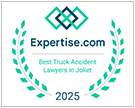Construction sites are full of powerful equipment, as well as loads of heavy materials. Workers are vulnerable to getting trapped under or between heavy machinery. And when they do, major injuries occur, including amputation or paralysis, which can permanently alter their lives.
Michael J. Lichner is a construction injury lawyer in Joliet who is committed to the rights of accident victims. He also wants to promote workplace safety in Illinois. He believes that personal injury cases benefit all workers, not only the injured victim. Contact our office to schedule a free consultation to discuss your caught in between or crush accident with a seasoned attorney.
What Are Common Caught In Between Accidents in Construction?
Caught in between accidents are slightly different from “struck by” accidents. When a worker is hit by something—say, a dump truck or a hammer falling off a roof—they have suffered a “struck by” injury. The mechanism of injury is the forceful impact.
With a caught-in-between accident, the injury is caused by the heavy weight of the object landing on top of the worker or resting on them for a prolonged time. This is usually a compression injury.
Some common caught in between accidents include:
- Loads sliding off a forklift and landing on a worker.
- Motor vehicles overturning and crushing a person nearby.
- A worker is performing maintenance on a dump truck between the frame and box when the box suddenly drops and crushes them.
- A worker trapped between a piece of machinery and the ground, wall, or another stationary object.
- Limbs caught in machines.
These are serious accidents that can lead to fractures, amputation, brain injury, and possibly even death. There are many safety lapses at job sites as general contractors cut corners, and workers end up paying the price.
Crush Accidents on the Job
Crush accidents are some of the most common caught in between accidents at job sites. They stem from prolonged compression on a limb. Unless a heavy object is immediately lifted, this compression is sometimes fatal.
A crush injury at work often occurs because a heavy load or piece of equipment is not properly secured. It either falls or slides off a forklift or even the roof, landing on top of a construction worker. In demolition jobs, a building could collapse and bury workers, who might not be rescued for hours.
Crush injuries are immediately traumatic. Depending on the weight, some workers might be knocked unconscious or even killed by a heavy weight slamming onto them. Serious harm is also possible when skeletal muscle breaks down from the trauma. This process is called “crush syndrome,” and the consequences are dire:
- Muscle cells can break down and release certain chemicals into the bloodstream.
- A victim’s kidneys can struggle when overwhelmed by the chemicals.
- Kidney failure can lead to permanent injury or possibly death.
- Doctors sometimes amputate a limb to halt crush syndrome and save the worker’s life. Other workers will end up needing treatment for kidney failure.
What to Do After a Crush Accident or Caught Between Construction Site Injury
Some workers fear that they will be blamed for the accident, possibly with some justification. For example, a worker might have ignored safety training while working on a machine. They could have carelessly failed to watch where they were going when they were trapped in between a motor vehicle and the wall of a building.
Fortunately, workers’ compensation benefits in Illinois are no-fault. As a result, your carelessness should not prevent you from receiving benefits. That doesn’t mean an employer or their insurance carrier won’t try to get out of paying benefits. We strongly encourage injured workers to reach out to an experienced Will County construction injury lawyer to go over what evidence is needed in a claim. Typically, you still need to prove the injury stemmed from working conditions.
In some cases, a worker might also file a personal injury lawsuit against a non-employer. Illinois law shields employers from liability in workplace accident cases, but you might have a claim against a product manufacturer, the property owner, or another defendant. Reach out to Michael J Lichner, who can analyze all possible defendants.
Estimating the Value of Your Claim
A common question with caught in between accidents in construction is, “How much is my claim worth?” It’s a difficult question to provide a general answer to. The workers’ compensation temporary disability benefits are calculated primarily on your average wage before the accident, as well as any permanent impairment you suffered.
By contrast, in a personal injury claim, the victim can seek compensation for all losses, including full compensation for lost income.
Many of our clients with crush injuries end up with permanent disabilities. These accidents are often catastrophic, with limb loss and no ability to return to work. The pain and mental distress are often considerable. Work with an attorney who understands how to seek full compensation for a long-term injury. For example, you might receive compensation for future losses, such as ongoing medical treatment or even loss of earning capacity. Pain and suffering, along with mental distress, can also make up a large portion of a personal injury settlement.
We can bring a lawsuit against anyone with partial liability for the crush injury at work. For example, manufacturers and designers of defective products are often defendants, and we can search for additional defendants.
Speak with Attorney Lichner Today
Caught in between accidents and crush injuries are among the worst we have seen on construction sites. Some workers will never return to construction trades, especially where they have suffered an amputation or other significant injury. They are often fearful of how they will make ends meet and provide for their families.
Workers’ compensation benefits are a critical lifeline, though they are not generous. Some workers also struggle to get a claim approved, even after a dramatic caught between accident. Contact our law office to schedule a free consultation so we can go over what evidence you will need.












